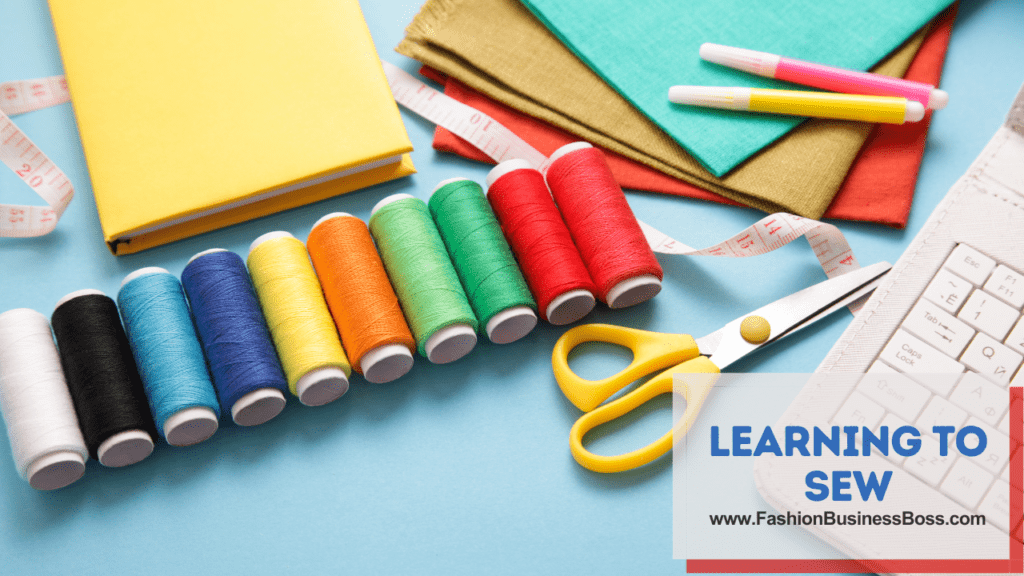Are you ready to step into the world of fashion design and turn your creative ideas into stylish garments that people will love to wear? If so, you’ve embarked on an exciting journey that allows you to express your unique vision and potentially turn it into a thriving business.
Here are some tips for aspiring fashion designers: find your unique style, master sewing skills, and build a strong online presence. Create, market, and conquer the fashion world.
In this article, we’ll take you through the steps to design and sell your own clothes, helping you navigate the dynamic world of fashion with style and confidence.
The Creative Process
Finding Your Unique Style

Establishing a distinctive clothing brand commences with identifying a style that distinguishes it from others. It’s essential to invest time in exploring and understanding your individual design preferences. Do you gravitate towards timeless sophistication, a free-spirited bohemian flair, or the urban coolness of streetwear? Your personal style serves as the cornerstone of your brand’s identity.
Your chosen style encapsulates the essence of your designs, shaping the visual language of your creations. It dictates the colors, patterns, and overall aesthetics that will define your brand. It’s akin to creating a unique fingerprint in the fashion world, allowing you to stand out amidst the crowd.
To embark on this journey, examine your own wardrobe and fashion choices. What types of clothing resonate with you the most? What themes or motifs consistently catch your eye? As you delve into this self-discovery process, you’ll uncover the elements that resonate with your inner designer, ultimately leading you towards a distinctive and memorable fashion identity.
Read more about: Designing Clothes from Scratch: A Creative Journey
Sketching Your Ideas
Begin the creative process by acquiring a sketchbook, a simple tool that can transform your design ideas into tangible forms. You need not possess professional artistic skills; rough sketches serve as a valuable medium to translate your thoughts into visuals.
Through sketching, you’ll find the ability to visualize your design concepts, breathing life into your imagination. Experimentation is key here – explore various shapes, patterns, and combinations of colors. Give yourself the liberty to allow your creative ideas to flow without constraint.
The beauty of sketching lies in its flexibility. These initial drawings are not intended for perfection but rather to serve as the initial stepping stones in the design journey. They act as a visual brainstorming session, allowing you to refine your ideas as they take shape on paper.
Sketching is the bridge that transforms your abstract notions into concrete designs. It’s a foundational step where creativity knows no bounds, paving the way for the creation of unique and imaginative clothing pieces.
Materials and Fabrics
The process of crafting your clothing line hinges significantly on the selection of suitable materials. This decision carries substantial weight as it directly influences the comfort, longevity, and visual appeal of your creations.
When making your choices, factor in the comfort aspect – how will the fabric feel against the skin of the person wearing your garment? Durability is equally vital, as your customers expect clothing that withstands wear and tear.
Furthermore, aesthetics play a pivotal role. The fabric’s appearance should align with your design vision, harmonizing with the colors, patterns, and style you intend to convey.
To navigate this terrain wisely, acquaint yourself with diverse textile varieties. Learn about the characteristics of different fabrics, their suitability for various types of clothing, and their care requirements.
Remember, you don’t need to embark on this journey alone. Seek guidance from experts, whether at fabric stores or within online communities. Their insights and advice can serve as valuable compass points in your material selection process, guiding you towards choices that enhance the quality and appeal of your clothing creations.
Turning Designs into Reality
Learning to Sew

Acquiring the skill of sewing is an essential milestone in your journey to create your clothing designs. This expertise empowers you to transform your concepts into tangible garments that people can wear and enjoy.
There are several pathways to learn this valuable skill. Local sewing classes, often available in your community, provide hands-on guidance and structured learning. Instructors can impart fundamental sewing techniques and gradually advance your skills.
Alternatively, the digital era offers a wealth of online tutorials. These resources allow you to grasp sewing techniques at your own pace, making it accessible to those who prefer self-guided learning. Videos, articles, and instructional guides are readily available to aid your progress.
If you wish to expedite your clothing production or seek mentorship, you have the option to enlist the services of a skilled seamstress. Their expertise can complement your vision, ensuring the meticulous craftsmanship of your clothing pieces.
As you delve into the art of sewing, you’ll appreciate the intricate process and artistry that goes into crafting each garment. Your dedication to mastering this craft will be a valuable asset in bringing your clothing designs to life.
Read more about: Designing Your Destiny: A Clothing Brand
Creating Prototypes
Prior to embarking on large-scale production, it’s prudent to craft prototypes of your clothing designs. Think of these prototypes as preliminary versions of your envisioned garments. This step serves several vital purposes in your design journey.
Firstly, prototypes enable you to fine-tune your patterns. Patterns are like blueprints that guide the construction of your clothing. Prototyping allows you to test these blueprints in real-life scenarios, identifying any areas that may require adjustments or improvements.
Secondly, it provides an opportunity to make necessary alterations. During the prototype phase, you can pinpoint aspects like fit, comfort, and overall functionality. This hands-on approach allows you to address any issues or enhancements required to align your designs with your standards.
Lastly, crafting prototypes ensures that your final product aligns with your vision. It’s an essential quality control measure, ensuring that the garments you produce meet your expectations in terms of quality, aesthetics, and functionality.
Sourcing Manufacturers
If your goal is to manufacture your clothing line on a larger scale, it’s essential to embark on thorough research to identify dependable manufacturing partners. Alternatively, you might contemplate the possibility of establishing your production facility. The primary focus in either case should be to maintain unwavering dedication to quality.
Begin by investigating potential manufacturing partners. Look for companies or facilities with a track record of producing clothing items similar to your designs. Verify their reputation for delivering products that meet high standards of quality.
When assessing potential partners, scrutinize their commitment to maintaining the quality you envision for your clothing line. It’s crucial that they share your dedication to producing garments that not only meet but also exceed your expectations.
On the other hand, if you’re considering in-house production, assess the feasibility and costs associated with setting up your production facility. This option provides you with greater control over the manufacturing process, ensuring your designs are brought to life with meticulous attention to detail.
Selling Your Creations
Setting Up an Online Store

To expand the reach of your clothing line, establishing an online store is crucial. This digital platform enables potential customers to explore and purchase your creations from the comfort of their homes. Here’s a concise guide to set up your e-commerce website.
Begin by building a user-friendly website that showcases your clothing line. You can use popular e-commerce platforms or hire web developers for a customized solution.
Ensure your website is easy to navigate. Organize your products into clear categories, providing filters to simplify customer searches.
Invest in robust security features to protect both customer data and your business. SSL certificates and secure payment gateways are essential components.
Utilize high-quality, professional product photography to showcase your creations effectively. Clear, visually appealing images help customers make informed choices.
Optimize your website for mobile devices, as many customers shop using smartphones and tablets. A responsive design ensures a seamless shopping experience on all screen sizes.
Read more about: Designing Your Destiny: The Best Start for a Clothing Company
Pricing Strategies
Setting the right price for your products or services is a critical aspect of running a business. Your pricing should strike a balance between reflecting the value of what you offer and remaining competitive in the market.
Start by considering your production costs. This includes not just the direct costs of materials and labor but also indirect costs like rent and utilities. Understanding your cost structure is essential to avoid selling at a loss.
For example, if you create handcrafted jewelry, consider the costs of the gemstones, metals, and the time you spend crafting each piece. These costs should inform your pricing decisions.
Next, assess the market. Research your competitors and their pricing strategies. This will give you insights into what customers are willing to pay for similar offerings.
For instance, if similar jewelry pieces in the market are priced between $50 and $100, you can use this information to determine where your products fit in terms of pricing.
Your brand’s positioning also plays a crucial role. If you position yourself as a premium brand, your pricing can reflect that. Conversely, if you aim to appeal to budget-conscious consumers, your prices should be competitive and affordable.
Customer Engagement
Effective customer engagement is the cornerstone of a thriving business. It revolves around providing top-notch customer service and maintaining open, honest communication with your customers. This process hinges on simple yet powerful principles that can be understood by anyone.
Firstly, it’s crucial to prioritize exceptional customer service. This means going the extra mile to meet your customers’ needs and expectations. When a customer encounters a problem or has a question, respond promptly and helpfully. By addressing their concerns, you build trust and goodwill.
Listening to your customers is another vital aspect of engagement. Pay attention to their feedback, whether positive or negative. Constructive criticism can lead to valuable improvements. Act on this feedback to enhance your products or services, showing that you value their opinions.
Conclusion
Starting your own clothing brand is a challenging yet fulfilling endeavor. It requires creativity, determination, and a willingness to learn from both improvements and setbacks. Remember, even the most renowned designers started small. Embrace your role as a Master of your craft, and let your passion for fashion drive your growth.
Frequently Asked Questions

Q: How do I begin designing my own clothes?
A: To start designing your own clothes, first, find your unique style and sketch your ideas. Consider taking sewing classes or learning online to acquire the necessary skills.
Q: What materials should I use for my clothing designs?
A: The choice of materials depends on your design and purpose. Research and select fabrics based on comfort, durability, and aesthetics. Seek expert advice if needed.
Q: How can I protect my clothing designs from being copied?
A: To safeguard your designs, consider registering trademarks and copyrights. This legal protection will help prevent others from copying your creations.
Q: What is the best way to market and promote my clothing brand?
A: Effective marketing strategies include creating a user-friendly website, utilizing social media for exposure, and engaging with your audience through various channels like email marketing and influencer partnerships.
Q: How to scale a clothing business as it grows?
A: To expand your clothing brand, consider introducing new collections, collaborating with influencers or retailers, and maintaining high-quality customer service to retain and attract customers.
To learn more about starting your own clothing business, check out my startup documents here.
Please note that the contents of this blog are for informational and entertainment purposes only and should not be construed as legal advice. Any action taken based on the information provided in this blog is solely at your own risk. Additionally, all images used in this blog are generated under the CC0 license of Creative Commons, which means they are free to use for any purpose without attribution.

Meet Shawn Chun: Entrepreneur and Fashion Business Fan.
I’m a happy individual who happens to be an entrepreneur. I have owned several types of businesses in my life from a coffee shop to an import and export business to an online review business plus a few more and now I create online resources for those interested in starting new ventures. It’s demanding work but I love it. I do it for those passionate about their business and their goals. That’s why when I meet a designer or boutique owner at a craft fair, farmers market, retail location or anywhere else I see myself. I know how hard the struggle is to retain clients, find good employees and keep the business growing all while trying to stay competitive.
That’s why I created Fashion Business Boss: I want to help fashion business owners like you build a thriving business that brings you endless joy and supports your ideal lifestyle.

